

Signal theory :
introduction
Keywords : tutorial, signal theory, linear systems, invariant with time linear systems, dirac, complex exponential, vector, signal, eigen vectors, causality, fourier transform, vectorial space, convolution, fourier transform, localisation, delocalisation, intrinsic frequency resolution of fourier transform, nexyad, applied maths,
Written by Gerard YAHIAOUI and Pierre DA SILVA DIAS, main founders of the applied maths research company NEXYAD, © NEXYAD, all rights reserved : for any question, please CONTACT
Reproduction of partial or complete content of this page is authorized ONLY if "source : NEXYAD http://www.nexyad.com" is clearly mentionned.
This tutorial was written for students or engineers that wish to understand main hypothesis and ideas of linear signal processing.
Notations of digital signals was intentionnaly used in order to fit into engineers expectations (ex : dicrete sums intead of continuous sums).
Dirac distribution, Dirac vector base
Keywords : tutorial, signal theory, linear systems, invariant with time linear systems, dirac, complex exponential, vector, signal, eigen vectors, causality, fourier transform, vectorial space, convolution, fourier transform, localisation, delocalisation, intrinsic frequency resolution of fourier transform, nexyad, applied maths,
Written by Gerard YAHIAOUI and Pierre DA SILVA DIAS, main founders of the applied maths research company NEXYAD, © NEXYAD, all rights reserved : for any question, please CONTACT
Reproduction of partial or complete content of this page is authorized ONLY if "source : NEXYAD http://www.nexyad.com" is clearly mentionned.
This tutorial was written for students or engineers that wish to understand main hypothesis and ideas of linear signal processing.
Notations of digital signals was intentionnaly used in order to fit into engineers expectations (ex : dicrete sums intead of continuous sums).
Dirac distribution, Dirac vector base
Vectors
base of the signals vectorial space : natural base
"Every signal can be considered as a succession of impulses". Mathematically, this leads to say that for a given signal ,
it is always possible to write :
,
it is always possible to write :  (1)
(1)
 is
the
dirac impulse signal
is
the
dirac impulse signal
NB : in must papers and books, the arrow is not drawn on the vectors (yes signals are vectors ! ...). In such a case, S(t) may be either the "signal" (= the vector = the complete entity that goes from to
to
 ), or the value that this entity S takes at time t. Only the context
allows the reader to understand (it actually mostly brings
misanderstanding).
), or the value that this entity S takes at time t. Only the context
allows the reader to understand (it actually mostly brings
misanderstanding).
In our presentation, we prefered to make the difference explicitely, although it adds sometimes "many" arrows (that's the reason why must people don't put the arrows on vectors).
One can notice that
the
list of values of
the signal {S(i} is NOT
the signal : it is the list of co-ordinates of the vector (signal
entity) in a particular vector base : the Diracs vector base (one can
demonstrate that the set of diracs at every time location is a vector base
A dirac is supposed to be a distribution with an infinite height, a null width, and a surface equal to 1 ... In practice, you may have an idea of a dirac as a "very thin" impusion with a height equal to 1 : of the signals vectorial space : this base is called the "natural" base).
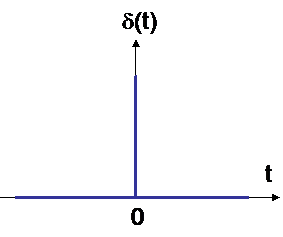
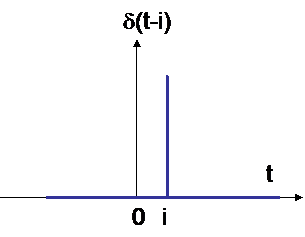
(time location of a dirac can obviously be changed as shown above)
Then, (1) can be represented as follow :
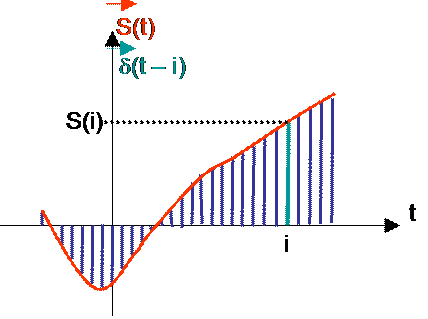
NB : in continuous time, sums are continuous (the above figure is a discrete representation).
Linear transformations
For linear systems, the superposition principle applies :

For a signal, It means that :

One can notice that this is the "classical" way of writing a linear transformation of vectors in vectorial spaces : knowing the transformation for every vector of the base allows to deduct the transformation of any vector :
example in the plan vectorial space (2 dimensions ... like in the old school ...) :
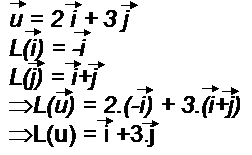
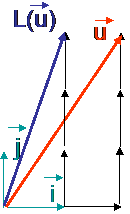
The vectors of the natural base (dirac impulses) are "all the same vectors" shifted in time. So their transformation through L is also the same response shifted in time.
Then knowing the transformation of the dirac impulse is enough to deduct the transformation of any signal through the linear function L.
The transformation of the dirac impulse through L is called the "impulse response" of L.
It means that if one put a dirac impulse as input to a linear system L and record the output ... then it is possible to predict the output of L for any input signal :
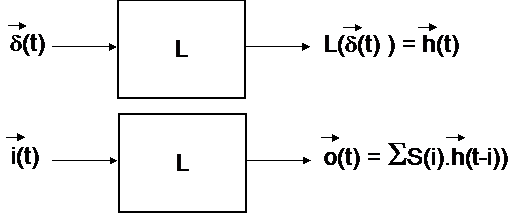 (2)
(2)
(2) is used to define a new mathematical internal operation between signals : the convolution.
 (3)
(3)
One can demonstrate that convolution * is reflexive.
Then, replacing the input vector i by the dirac impulse into (2) obviously shows that the dirac impulse is the neutral element of convolution *
Matrix view of convolution
Convolution operation hides a matrix operation
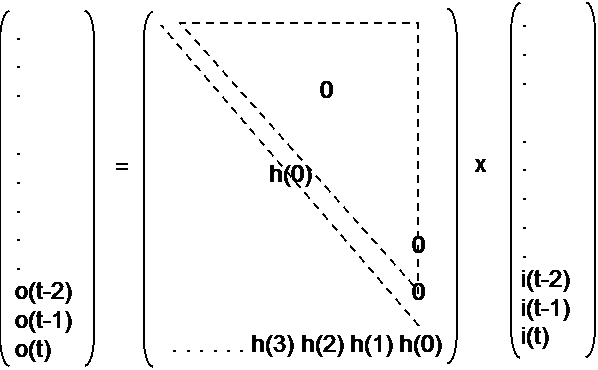 (4)
(4)
Because most papers and books present signal theory in the case of contiuous time and also because even in case of discrete time, one can notice that the matrix has an infinite height and width ... it is rare to see this representation.
This representation is interest of us because it allows to make a very intuitive introduction of Fourier Transform (see below).
One can notice that this matrix IS NOT a diagonal matrix.
It means that dirac impulses are not Eigen vectors of Linear transformations.
Reminder 1 : the interest of working in an Eigen vectors base is that the matrix of L would be then a diagonal matrix : such a matrix makes co-ordinate n°k of the output signal depend only on co-ordinate n°k of the input signal ...
example :

O1 = a11 . i1
O2 = a22 . i2
The values that are not on the first diagonal are the "blending" coefficients : they make output n°k depend on inputs n° i :

O1 = a11 . i1 + a12 . i2 , O1 depends on i1, but also on i2
O2 = a21 . i1 + a22 . i2 , O2 depends on i2, but also on i1
One also can notice that the matrix of a linear transformation L is made of zeros for all coefficients that are localized upper than the first diagonal : these coefficients are the "future" of time t : output at time t cannot depends on values of input at times (t+1), (t+2), ...
This property is called CAUSALITY : output at time t depends on every inputs at times .... , (t-i), ...., (t-2), (t-1), t :
Let us consider the transformation L that is characterized by its impulse response h(t) :
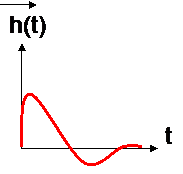
Then o(ti) depends on the past of among
the whole duration of
among
the whole duration of  :
:
(NB : this duration may be infinite)
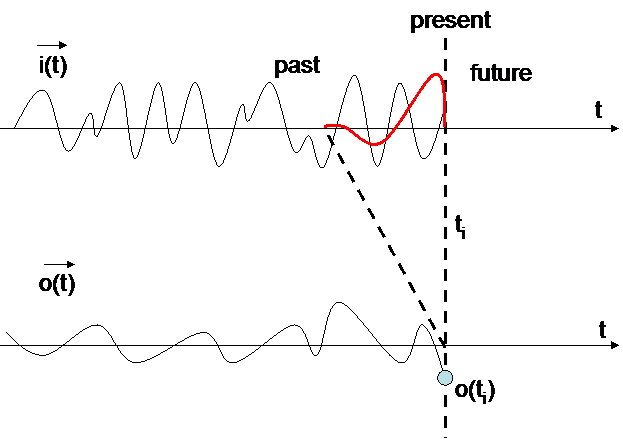
Reminder 2 : the Eigen vectors are those that doesn't change their direction through the transformation L :
L(vector U) = Lambda.(vector U) : the Eigen vector U is only mutiplied by a number.
For a signal, it means that eigen vectors are those that doesn't change their "shape" through the Linear transformation.
Every student that followed some electricity/electronics courses knows that sinusoidal signals have this property :
If input signal is a sinusoid of frequency f and amplitude A, then the output of any linear system L should be a sinusoid of frequency f (it means exactly the same shape) and amplitude B ...
B/A is called the gain of L for the frequency f.
But the output sinusoid is also delayed of an angle Teta.
This delay makes it impossible to consider sinusoids as Eigen vectors ... (delay is not a multiplication of the signal by a number).
So the idea is to use "complex sinusoids" instead of "real" ones, because in complex space, delay is written as a multiplication by exp(-i.Teta).
(the gain stays a multiplication, the delay become a multiplication, => the whole transformation is then only a multiplication of the vector by a number (a complex number) ... definition of Eigen vectors).
Discrete Fourier Transform
Changing from the natural base (the diracs) to this new base (the "complex sinusoids") will lead to represent L with a diagonal matrix.
As usual with vectors, finding the components of a vector on a new vectors base is obtained by writing the scalar product between the vector and every elementary vector of the new base.
For every new component n°f, it is then possible to get this co-ordinate by a simple scalar vector :
 (5)
(5)
The vector signal that
is written
that
is written  in
the natural base is then written
in
the natural base is then written  in
the Eigen vectors base, and every co-ordinate I(f) of
in
the Eigen vectors base, and every co-ordinate I(f) of  is
computed with the scalar product above that is called the DISCRETE
FOURIER TRANSFORM of the signal
is
computed with the scalar product above that is called the DISCRETE
FOURIER TRANSFORM of the signal  .
.
The new base vectors ("complex sinusoids" are not characterized by a time location - because they exist from minus infinite to plu infinite - but they are characterized by their frequencies) leads to a matrix of L that is a diagonal : output signal for frequency number fi depends ONLY on input signal for frequency number fi (via multiplication by a number that is expected to be a complex number, the real part being the gain, and the complex exponential part being the time delay).
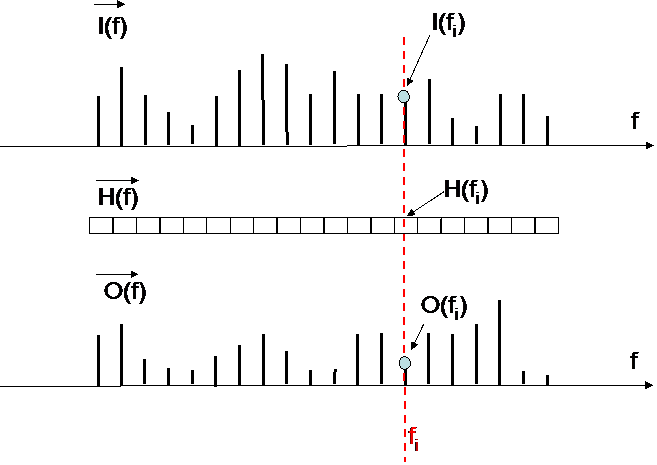
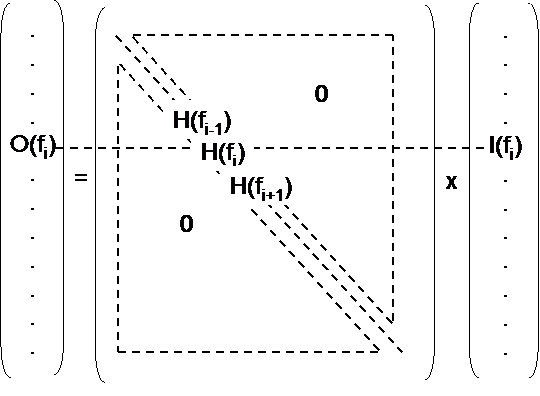
That is why one generally says that FOURIER TRANSFORM transforms convolution into multiplication (in fact it is a multiplication of a diagonal matrix by a signal).
But one can define an operation that takes the diagonal of the matrix and creates a vector made with its values, and create an external multiplication between vectors ... building then a new internal operation x that allows to build a new vectorial space ...
Doing that allows to consider that the FOURIER TRANSFORM is an application between two vectorial spaces :
- space of time representation using * : vectorial space n°1
- space of frequency representation using x : vectorial space n°2
Because vectorial space n°2 was created on the basis of a simple change of vectors base ... it is obvious that there exist an isomorphism between vectorial space 1 and vectorial space 2 !
Basic properties of Fourier Transform
Fourier Transform of the impulse response of a linear system L is called the TRANSFERT FUNCTION of L :

NB : transformation of dirac impulse into a constant vector made of "1" is obvious : isomorphisms tranform neutral element of internal operation 1 (here : the convolution) into the neutral element of the internal operation 2 (here : the multiplication) ...
It also can be demonstrated that multiplication is transformed into convolution via a FOURIER TRANSFORM.
The inverse transformation is also a scalar product ... with diracs at every delayed location - beware : delayed diracs are written in the frequency co-ordinates : delay becomes an exponential ... - ... This transformation is called INVERSE FOURIER TRANSFORM.
Let us just notice the duality of localisation / delocalisation when changing from vectorial space 1 to vectorial space 2 :
Examples :
Sinusoid is totally delocalised in time : FOURIER TRANSFORM localises it into 2 points (by construction cf. above) :

Dirac impulse is totally localised in time and becomes totally delocalised in frequency :

Square signal of width T is localised into a finite time support T and it becomes a delocalised sin(x)/x :

NB1 : one can notice that the more the short T, the biggest the 1/T
Ifever T tends to zero, then square(t) looks like an impulse signal, and its Fourier transform looks like 1(f)
NB2 : square(t) is a very IMPORTANT signal in signal processing, because in practice, it is not possible to acquire a signal during an infinite duration : signal capture (through sensors ...) leads to a signal that is known during a finite duration ...
One can consider the acquired signal as a multiplication of the theoretical signal (that is infinite in time) and a square(t) signal of lenght T : T is the duration of the acquisition.
But because multiplication x becomes convolution * through a Fourier Transform, then the Fourier Transform of the acquired signal will be the convolution of a sin(x)/x signal with the Fourier Transform of the theoretical signal (with infinite duration).
In particular, for a piece of sinusoid (duration = T), one gets :

This leads to what is called "intrinsic frequency resolution of fourier transform" : one cannot put several sinx/x shapes together on the same diagram without blending them ... except every 1/T
Beware ! Ifever your signal exists during 10-3 s ... then you will have a relevant point of the Fourier Transform ... every 1000 Hz !
The more the duration of capture, the best the frequency resolution ... but the worse the time localisation of your extracted information ...
"Every signal can be considered as a succession of impulses". Mathematically, this leads to say that for a given signal
 ,
it is always possible to write :
,
it is always possible to write :  (1)
(1)
 is
the
dirac impulse signal
is
the
dirac impulse signalNB : in must papers and books, the arrow is not drawn on the vectors (yes signals are vectors ! ...). In such a case, S(t) may be either the "signal" (= the vector = the complete entity that goes from
 to
to
 ), or the value that this entity S takes at time t. Only the context
allows the reader to understand (it actually mostly brings
misanderstanding).
), or the value that this entity S takes at time t. Only the context
allows the reader to understand (it actually mostly brings
misanderstanding).In our presentation, we prefered to make the difference explicitely, although it adds sometimes "many" arrows (that's the reason why must people don't put the arrows on vectors).
One can notice that
A dirac is supposed to be a distribution with an infinite height, a null width, and a surface equal to 1 ... In practice, you may have an idea of a dirac as a "very thin" impusion with a height equal to 1 : of the signals vectorial space : this base is called the "natural" base).


(time location of a dirac can obviously be changed as shown above)
Then, (1) can be represented as follow :

NB : in continuous time, sums are continuous (the above figure is a discrete representation).
Linear transformations
For linear systems, the superposition principle applies :

For a signal, It means that :

One can notice that this is the "classical" way of writing a linear transformation of vectors in vectorial spaces : knowing the transformation for every vector of the base allows to deduct the transformation of any vector :
example in the plan vectorial space (2 dimensions ... like in the old school ...) :


The vectors of the natural base (dirac impulses) are "all the same vectors" shifted in time. So their transformation through L is also the same response shifted in time.
Then knowing the transformation of the dirac impulse is enough to deduct the transformation of any signal through the linear function L.
The transformation of the dirac impulse through L is called the "impulse response" of L.
It means that if one put a dirac impulse as input to a linear system L and record the output ... then it is possible to predict the output of L for any input signal :
 (2)
(2)(2) is used to define a new mathematical internal operation between signals : the convolution.
 (3)
(3)One can demonstrate that convolution * is reflexive.
Then, replacing the input vector i by the dirac impulse into (2) obviously shows that the dirac impulse is the neutral element of convolution *
Matrix view of convolution
Convolution operation hides a matrix operation
 (4)
(4)Because most papers and books present signal theory in the case of contiuous time and also because even in case of discrete time, one can notice that the matrix has an infinite height and width ... it is rare to see this representation.
This representation is interest of us because it allows to make a very intuitive introduction of Fourier Transform (see below).
One can notice that this matrix IS NOT a diagonal matrix.
It means that dirac impulses are not Eigen vectors of Linear transformations.
Reminder 1 : the interest of working in an Eigen vectors base is that the matrix of L would be then a diagonal matrix : such a matrix makes co-ordinate n°k of the output signal depend only on co-ordinate n°k of the input signal ...
example :

O1 = a11 . i1
O2 = a22 . i2
The values that are not on the first diagonal are the "blending" coefficients : they make output n°k depend on inputs n° i :

O1 = a11 . i1 + a12 . i2 , O1 depends on i1, but also on i2
O2 = a21 . i1 + a22 . i2 , O2 depends on i2, but also on i1
One also can notice that the matrix of a linear transformation L is made of zeros for all coefficients that are localized upper than the first diagonal : these coefficients are the "future" of time t : output at time t cannot depends on values of input at times (t+1), (t+2), ...
This property is called CAUSALITY : output at time t depends on every inputs at times .... , (t-i), ...., (t-2), (t-1), t :
Let us consider the transformation L that is characterized by its impulse response h(t) :

Then o(ti) depends on the past of
 among
the whole duration of
among
the whole duration of  :
:
(NB : this duration may be infinite)

Reminder 2 : the Eigen vectors are those that doesn't change their direction through the transformation L :
L(vector U) = Lambda.(vector U) : the Eigen vector U is only mutiplied by a number.
For a signal, it means that eigen vectors are those that doesn't change their "shape" through the Linear transformation.
Every student that followed some electricity/electronics courses knows that sinusoidal signals have this property :
If input signal is a sinusoid of frequency f and amplitude A, then the output of any linear system L should be a sinusoid of frequency f (it means exactly the same shape) and amplitude B ...
B/A is called the gain of L for the frequency f.
But the output sinusoid is also delayed of an angle Teta.
This delay makes it impossible to consider sinusoids as Eigen vectors ... (delay is not a multiplication of the signal by a number).
So the idea is to use "complex sinusoids" instead of "real" ones, because in complex space, delay is written as a multiplication by exp(-i.Teta).
(the gain stays a multiplication, the delay become a multiplication, => the whole transformation is then only a multiplication of the vector by a number (a complex number) ... definition of Eigen vectors).
Discrete Fourier Transform
Changing from the natural base (the diracs) to this new base (the "complex sinusoids") will lead to represent L with a diagonal matrix.
As usual with vectors, finding the components of a vector on a new vectors base is obtained by writing the scalar product between the vector and every elementary vector of the new base.
For every new component n°f, it is then possible to get this co-ordinate by a simple scalar vector :
 (5)
(5)The vector signal
 that
is written
that
is written  in
the natural base is then written
in
the natural base is then written  in
the Eigen vectors base, and every co-ordinate I(f) of
in
the Eigen vectors base, and every co-ordinate I(f) of  is
computed with the scalar product above that is called the DISCRETE
FOURIER TRANSFORM of the signal
is
computed with the scalar product above that is called the DISCRETE
FOURIER TRANSFORM of the signal  .
.The new base vectors ("complex sinusoids" are not characterized by a time location - because they exist from minus infinite to plu infinite - but they are characterized by their frequencies) leads to a matrix of L that is a diagonal : output signal for frequency number fi depends ONLY on input signal for frequency number fi (via multiplication by a number that is expected to be a complex number, the real part being the gain, and the complex exponential part being the time delay).


That is why one generally says that FOURIER TRANSFORM transforms convolution into multiplication (in fact it is a multiplication of a diagonal matrix by a signal).
But one can define an operation that takes the diagonal of the matrix and creates a vector made with its values, and create an external multiplication between vectors ... building then a new internal operation x that allows to build a new vectorial space ...
Doing that allows to consider that the FOURIER TRANSFORM is an application between two vectorial spaces :
- space of time representation using * : vectorial space n°1
- space of frequency representation using x : vectorial space n°2
Because vectorial space n°2 was created on the basis of a simple change of vectors base ... it is obvious that there exist an isomorphism between vectorial space 1 and vectorial space 2 !
Basic properties of Fourier Transform
Fourier Transform of the impulse response of a linear system L is called the TRANSFERT FUNCTION of L :

NB : transformation of dirac impulse into a constant vector made of "1" is obvious : isomorphisms tranform neutral element of internal operation 1 (here : the convolution) into the neutral element of the internal operation 2 (here : the multiplication) ...
It also can be demonstrated that multiplication is transformed into convolution via a FOURIER TRANSFORM.
The inverse transformation is also a scalar product ... with diracs at every delayed location - beware : delayed diracs are written in the frequency co-ordinates : delay becomes an exponential ... - ... This transformation is called INVERSE FOURIER TRANSFORM.
Let us just notice the duality of localisation / delocalisation when changing from vectorial space 1 to vectorial space 2 :
Examples :
Sinusoid is totally delocalised in time : FOURIER TRANSFORM localises it into 2 points (by construction cf. above) :

Dirac impulse is totally localised in time and becomes totally delocalised in frequency :

Square signal of width T is localised into a finite time support T and it becomes a delocalised sin(x)/x :

NB1 : one can notice that the more the short T, the biggest the 1/T
Ifever T tends to zero, then square(t) looks like an impulse signal, and its Fourier transform looks like 1(f)
NB2 : square(t) is a very IMPORTANT signal in signal processing, because in practice, it is not possible to acquire a signal during an infinite duration : signal capture (through sensors ...) leads to a signal that is known during a finite duration ...
One can consider the acquired signal as a multiplication of the theoretical signal (that is infinite in time) and a square(t) signal of lenght T : T is the duration of the acquisition.
But because multiplication x becomes convolution * through a Fourier Transform, then the Fourier Transform of the acquired signal will be the convolution of a sin(x)/x signal with the Fourier Transform of the theoretical signal (with infinite duration).
In particular, for a piece of sinusoid (duration = T), one gets :

This leads to what is called "intrinsic frequency resolution of fourier transform" : one cannot put several sinx/x shapes together on the same diagram without blending them ... except every 1/T
Beware ! Ifever your signal exists during 10-3 s ... then you will have a relevant point of the Fourier Transform ... every 1000 Hz !
The more the duration of capture, the best the frequency resolution ... but the worse the time localisation of your extracted information ...
For
more questions or applications,
please feel free to contact
us